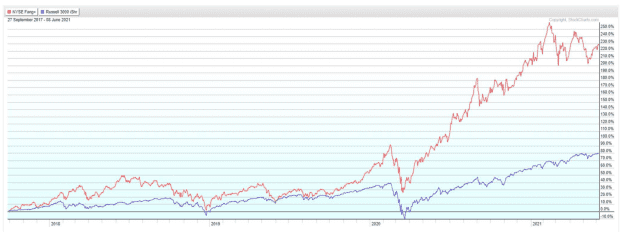FANG+ steps back as other stocks trade leadership, analyst notes
Major U.S. stock indexes are struggling to make big moves, but the ability of a range of stocks to push higher even as formerly highflying, mega-cap technology shares take a breather points to a market that remains healthy and unlikely to suffer a near-term breakdown, argued one Wall Street chart watcher on Wednesday.
“The most popular averages might not yet be back up to new highs, but many other market measures are already there, including the Value Line Geometric Index, the Wilshire 5000 W5000, 0.62%, the Russell 3000 RUA, 0.62%, and the NYSE/NYSE Common Stock Only/NYSE Volume/S&P 500 advance-decline lines,” said technical analyst Andrew Adams in a note for Saut Strategy.
“Additionally, at least 50% of stocks on the NYSE have remained above their
50-day moving average since early November, and, except for a brief period last
month, at least 80% of the NYSE has stayed above their 200-day moving
averages,” Adams wrote.
50-day moving averages are viewed as a reflection of an asset’s short-term trend, while the 200-day average reflects the long-term trend.
The S&P 500 SPX, 0.68% was up 0.1% on Wednesday after briefly trading above its May 7 record close of 4,232.60. The Dow Jones Industrial Average DJIA, 0.68% was up less than 0.1%, trading not far off its record close of 34,777.76. The tech-heavy Nasdaq Composite COMP, 0.79% has outperformed its peers this week and was up 0.2% on Wednesday.
Read: Why stock traders say ‘never short a dull market’
Stocks have largely moved sideways since the early May highs. Activity this week has been particularly muted, with analysts citing anticipation ahead of the release of the May consumer-price index on Thursday. A hotter-than-expected April CPI reading briefly rattled markets last month.
Meanwhile, the ability of the broader market to score strong gains this year as high-profile tech-related stocks took a back seat is noteworthy, Adams said.
Over the past few years, strong gains for the so-called FAANG+ stocks — an acronym for Facebook Inc. FB, 0.20%, Apple Inc. AAPL, 0.51%, Amazon.com Inc. AMZN, 1.18%, Netflix Inc. NFLX, -0.20%, Google parent Alphabet Inc. GOOG, 1.02% GOOGL, 0.78% and other high-profile stocks — probably made the market “look a lot better than it probably was given how well they performed and how highly they are weighted in the indices,” Adams wrote.
But now, investors are seeing a more equitable distribution of “winners” in the market, as other groups take the reins and former leaders pull back, he said.
In the chart below, Adams tracks the performance of the NYSE FANG+ Index NYFANG, 0.77% versus the iShares Russell 3000 exchange-traded fund IWV, 0.64%. The Russell 3000 aims to serve as a benchmark for the total U.S. stock market.

Adams noted that FANG-type stocks have clearly dominated, returning almost 230% since mid-2017 versus 80% for the much broader Russell 3000. Since the start of 2021, however, it’s been a different story, with the Russell 3000 putting in a much more consistent performance and continuing to rise, while the FANG+ index has pulled back and hasn’t seen a new high since February.
“This has meant that the market hasn’t been quite so dependent on the big tech stocks at the top and the performance has been more evenly distributed across other areas,” he said.
Adams noted that it’s been hard to tell which group is going to be in the lead on any given day in a market that’s seen few, clear uptrends in individual stocks and sectors.
“It is next to impossible to guess which group will take the lead from day to day, but the very fact that it keeps happening is helping to provide somewhat of a floor to how low the indices go because it’s been rare to see sessions where everything gets sold,” he wrote.
In recent action, 60% to 70% of NYSE operating companies have advanced on “good” days, but around 40% have managed to close higher on “bad” days, he said. “For those expecting a significant drop, such obvious strength is going to have to disappear first.”

